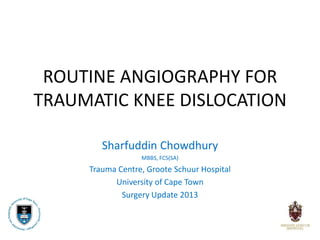
Dr. sharfuddin chowdhury uct surgery update 2013
- 1. ROUTINE ANGIOGRAPHY FOR TRAUMATIC KNEE DISLOCATION Sharfuddin Chowdhury MBBS, FCS(SA) Trauma Centre, Groote Schuur Hospital University of Cape Town Surgery Update 2013
- 2. Current controversy! Diagnostic angiography should be performed on all knee dislocations or Only on those patients who demonstrate abnormal findings on physical examination
- 3. Background • Knee dislocation = popliteal artery injury 21% to 81% • Amputation rate = popliteal artery injury 0 – 86 %
- 4. Knee dislocation Abnormal Angiography pulses Reduction Normal ? pulses Angiography
- 5. INJURY TO THE POPLITEAL ARTERY ASSOCIATED WITH DISLOCATION OF THE KNEE: PALPABLE DISTAL PULSES DO NOT NEGATE THE REQUIREMENT FOR ARTERIOGRAPHY The British Journal of Accident Surgery (1989) Vol 20/No.5 page 307-310 Case 1 • normal pulses post-reduction • 6hrs later – absent foot pulses / doppler • complete occlusion of popliteal artery • Outcome: Above knee amputation
- 6. INJURY TO THE POPLITEAL ARTERY ASSOCIATED WITH DISLOCATION OF THE KNEE: PALPABLE DISTAL PULSES DO NOT NEGATE THE REQUIREMENT FOR ARTERIOGRAPHY The British Journal of Accident Surgery (1989) Vol 20/No.5 page 307-310 Case 2 • normal pulses post-reduction • 24hrs later – absent foot pulses / cold • complete occlusion of popliteal artery with collateral distal reconstitution • Outcome: limb salvaged
- 7. VASCULAR INJURY ASSOCIATED WITH LOW VELOCITY DISLOCATIONS OF THE KNEE J Bone Joint Surg Br. 1987; 69; 285-287 • 4 cases: normal pulses • Angiography findings: 1. Complete occlusion (1) • revascularisation with limb salvage 2. Intimal injury (2) • (1) – Debridement for complete necrosis of anterior compartment on D5 • (2) – On exploration 5cm segment of intimal damage 3. Normal angiogram (1)
- 8. Does the Pulse Examination in Patients with Traumatic Knee Dislocation Predict a Surgical Arterial Injury? A Meta-analysis J Trauma 2002; 53: 1109-1114 116 Articles reviewed, 7 met inclusion criteria 18 (12.5%) 145 Positive 218 (66.5%) Normal pulses Arteriography 127 284 Normal Knee Dislocations 45 (68.2%) Positive 66 Patients 66 Abnormal pulses Arteriography 21 Normal
- 9. 10-Year review of knee dislocations: Is arteriography always necessary? J Trauma 2005 8 (28.5%) Positive 28 28 Normal pulses Arteriography 20 39 Normal Knee Dislocations 11 11 11 Abnormal pulses Arteriography Positive
- 10. GSH KNEE DISLOCATION EXPERIENCE M Held, R von Bormann, J Walters, A Banderker, P Navsaria, A Nicol Department of Orthopaedic Surgery and Trauma Centre 9 (18.8%) Positive 48 48 Normal pulses Arteriography 96 39 Knee Normal Dislocations (10 excluded for ischemia) 11 (28.9%) Positive 38 38 Abnormal pulses Arteriography 27 Normal
- 11. Conclusion • Knee Dislocation with normal pulses associated with 12 – 28% popliteal artery injury • An aggressive evaluation for an arterial injury will give us the best opportunity to avoid a missed injury and probable amputation • Angiography for all Traumatic Knee Dislocation with Normal Pulses
